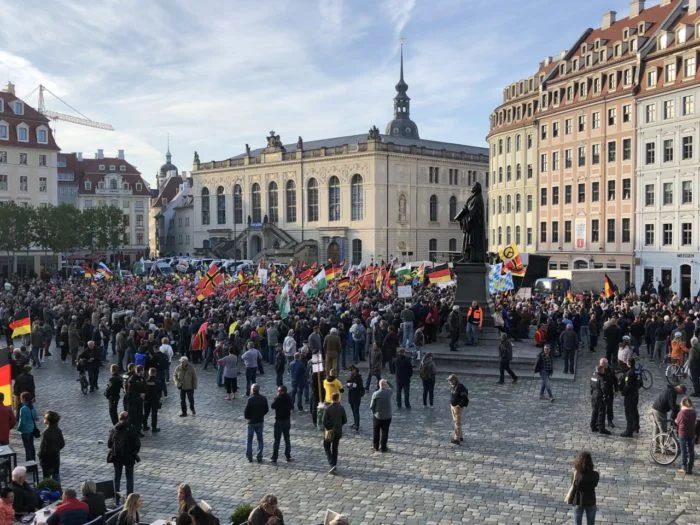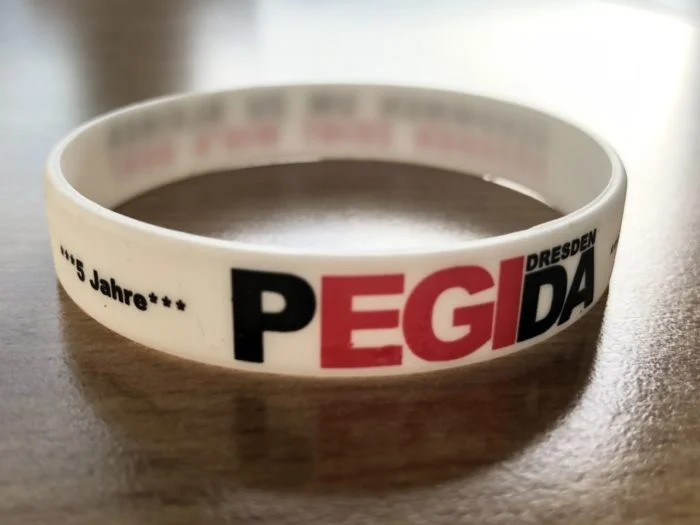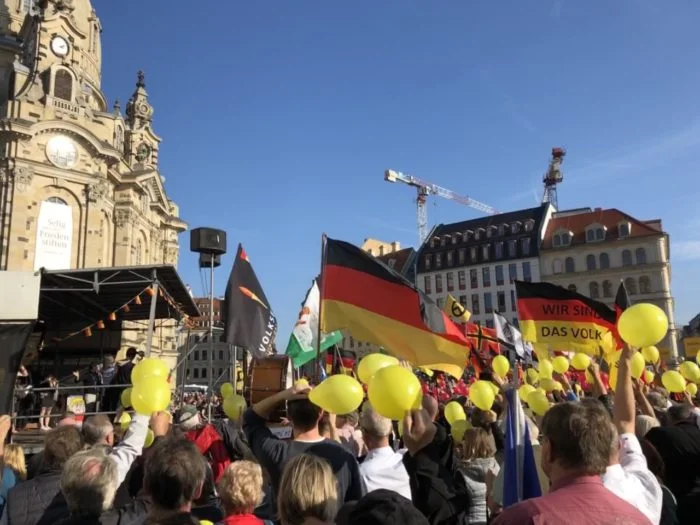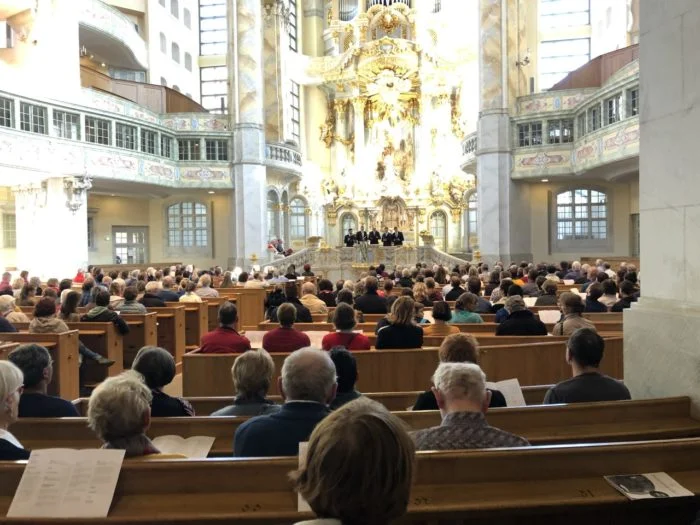‘Super Sunday’ of demonstrations in Dresden: The right-wing populist Pegida movement celebrates its five-year anniversary
by Sabine Volk
Pegida celebrated with around 2,500 followers and a couple of international guests on the past weekend. Several left-wing and pro-immigrant organizations from Dresden and other Saxon cities mobilized around 4,000 people for counter-demonstrations. Sabine Volk witnessed the polarized day amidst the crowds.

This 20 October is an exceptionally beautiful autumn Sunday in Dresden. The sun is shining bright and warm from a perfectly blue sky, while a light breeze blows yellow and red tree leaves through the air. It could be the perfect day to have a stroll at the river Elbe with family and friends, or to sit on one of Dresden’s many outdoor terraces, sipping a drink while contemplating the historically reconstructed architecture of the ‘Baroque City’. Yet, Dresden has not been as agitated for quite some time. On this Sunday, Dresden’s home-grown far-right populist movement Pegida, which stands short for ‘Patriotic Europeans against the Islamization of the Occident’ (Patriotische Europäer gegen die Islamisierung des Abendlandes), celebrates its five-year anniversary. The event takes place on the central New Market Square (Neumarkt), right between the iconic neo-Baroque Church of Our Lady (Frauenkirche)and the monument to the Catholic monk and church reformer Martin Luther. For five years now, the ‘Patriotic Europeans’ have been polarizing Dresden’s urban society as well as the German public writ large – a good reason to take a closer look at them.
Dresden’s so-called ‘Patriotic Europeans’
Pegida emerged on the streets of Dresden in October 2014. Within a couple of weeks only, the organizers, a group of friends from Dresden and its surroundings, managed to create a high level of publicity for their so-called ‘Monday demonstrations’ or ‘evening strolls’. Indeed, they rapidly mobilized ever larger crowds, starting off from only around 300 participants, and gathering up to 25,000 demonstrators in January 2015. The weekly demonstrations campaigned against the alleged Islamization of the Occident, the German and European political establishment as well as the ‘lying’ media and ‘liberal’ academia. At the same time, Pegida’s Facebook page attracted many supporters and quickly became the most popular right-wing organization’s website in Germany.
In late January 2015, however, photos of co-founder Lutz Bachmann posing as Adolf Hitler appeared in the media. This incident contributed to a conflict and the following split of the organizing team. After the more moderate members had left Pegida, a more radical group around Bachmann continued to campaign against the alleged growing influence of Islam in Europe. From February 2015 on, the speeches and contents on the Facebook page thus got even more radical. At the same time, the movement’s followership seemed to decline rapidly, as participant numbers dropped dramatically. Only the momentous summer of 2015, associated with the so-called European ‘refugee crisis’, gave new fuel to Pegida. For some time, the movement could mobilize more participants, but never reached its initial numbers. Yet, Pegida has never died off after the eventful months in 2015/2016. A core of around 1,500 participants still demonstrates in Dresden on a weekly or bi-weekly basis.
Celebrating Pegida’s five-year anniversary
The ‘Patriotic Europeans’ proudly celebrated their five-year anniversary on the exact same date as the first demonstration, which had taken place on 20 October 2014. The anniversary event slightly differed from the usual Pegida-demonstration. Most importantly, it was a stable event which featured only speeches, but no march, it was set up more professionally, using a real stage rather than a small truck with speakers, and, finally, the Pegida bosses dressed much more elegantly than on an average demonstration day. After all, this was supposed to be a solemn celebration.
The event started right on time with the theatrical ‘Pegida anthem’ resounding over the square. Over the following three hours, co-founder Lutz Bachmann consecutively invited nine guest speakers to the stage, all of them white men. Amongst them were many well-known German and European far-right extremists such as the activist Michael Stürzenberger who is currently ‘under observation’ of the Bavarian Office for the Protection of the Constitution (Bayerisches Landesamt für Verfassungsschutz), the member of the Bundestag Jens Maier who belongs to the völkisch, extremist wing of the AfD, which is similarly suspected of counter-constitutional activities, the Austrian far-right activist Martin Sellner from the Identitarian Movement, and the Belgian parliamentarian Sam van Rooy from the right-wing populist party Vlaams Belang.

Hate speech characterized this Sunday afternoon in Dresden’s picturesque Old Town. The noise made by the counter-demonstrators who had gathered at the opposite side of the square only sometimes managed to drown the demagogic speeches in whistles and shouts. Pegida’s nine guest speakers mostly focused on the venomous critique of Islam and immigration as such, as well as ‘the elites’. They coherently depicted Islam as a backward, violent and dangerous ideology which threatens European culture, tying in with the current trend of Islamophobic discourse in the western world. Also, they agitated against the German and European political establishment as well as the counter-demonstrators, blaming them to be ‘left-wing fascists’ (Linksfaschisten), anti-democrats and sluggards. Nevertheless, I was wondering if Bachmann had urged his guests to tame their rhetoric: although descending, the tone seemed virtually lenient in comparison to Bachmann’s latest references to Pegida’s opposition as ‘parasites which should be pushed into a trench and closed off’. The case is currently being investigated for sedition (Volksverhetzung).
Far-right extremism in denial
After Pegida’s emergence, the German public, and the left-wing scene in particular, had been quick, maybe somewhat to quick, to denounce the movement as a Nazi organization. Also at the anniversary event, the counter-demonstrators persistently chanted that ‘There is no right to Nazi propaganda, there is no right to Nazi propaganda’, denying the right to free expression to the demonstrators. Pegida organizers and supporters had always been overly sensitive to this judgment. Similarly, I overheard many private conversations emphasizing one’s civil, non-extremist identity and lamenting the ‘lack of freedom of opinion’ in Germany on this Sunday afternoon. Indeed, I must admit that the public did not look like a typical far-right crowd. It was quite diversified, gathering not only middle-aged men, but also young people, women, and a couple of families.
Pegida’s far-right extremist orientation is, however, undeniable. Not only did the crowd cheer loudest at the most hateful rhetoric, and repeated the by now familiar demonstration chants such as ‘lying press’(Lügenpresse) which roots in Nazi propaganda. In fact, a lot of people at the demonstration were obviously not ‘ordinary’ or ‘concerned’ citizens, but belonged to far-right organizations such as the Identitarian Movement, the associations EinProzent and Zukunft Heimat, the German neo-Nazi party NPD, etc. They proudly carried their flags and symbols to Dresden’s New Market Square: for instance, the black, red and yellow Wirmer Flag which has become a symbol of the so-called far-right extremist ‘resistance’, as well as the Lambda Flag of the Identitarian Movement. Some banners and posters revealed the crowd’s extremist ideology even more explicitly. The most striking banner, so far unseen at Pegida’s events, read: “Merkel is the biggest divider (Spalter)of German history. When will this creature be abolished?”. If Merkel is considered ‘the biggest divider of German history’, I honestly wonder why Pegida supporters are surprised to be denounced as Nazis.
Abusing history

Particularly disconcerting is Pegida’s constant abuse of history. Both speakers and followers appeal to a certain reading of Germany’s and Europe’s past through the targeted use of language, rituals and symbols. The most common historical reference concerns the so-called ‘Peaceful Revolution’ in East Germany in 1989/1990, when East German citizens overthrew the state socialist system of the former German Democratic Republic. Today, Pegida demonstrators write the 1989-slogan ‘We are the people’ (Wir sind das Volk) on their banners. Also, Jens Maier from the AfD claims that ‘the revolution must be finalized’, Christoph Berndt from the organization Zukunft Heimat suggests the past revolutionaries’ courage as an example for the ‘Patriotic Europeans’, and Martin Sellner from the Identitarian Movement evokes a famous GDR dissident and musician. The symbolic instrumentalization of the memory of 1989 suggests Pegida as the heir of the peaceful revolutionaries who fought for liberty and peace. Yet, Pegida cannot legitimately claim the heritage of 1989. Most demonstrators have not been involved, the AfD politician Jens Maier is from western Germany and the Identitarian Martin Sellner was still a small baby when the revolution took place.
Besides the further familiar historical claims made at Pegida demonstrations – for instance, the claim to the heritage of the German resistance against Nazism through the use of the Wirmer Flag, or the allusions to Greek mythology expressed by the Identitarian Movement’s Lambda symbol– the anniversary event featured some surprising additions to Pegida’s usual repertoire. The far-right activist Michael Stürzenberger sought to spice up his speech with a collection of quotes from ‘great European thinkers’ such as the church reformer Martin Luther, but also from Karl Marx. He strategically chose passages from their writings which expressed an anti-Islamic position, nurturing his argument that ‘Islam has always been a threat to Europe’. Once more, Pegida strategically deployed allusions to history in order to create the idea that the movement is the continuation of earlier dissident and opposition movements, and to strike a parallel between the current state of German democracy and totalitarian systems such as the GDR or Hitler’s Third Reich.
The counter protest dominates – does it? Is Dresden lost to far-right propaganda and the populist abuse of history? Luckily, this is not the whole picture. On this Sunday afternoon at least, the liberal part of civil society set a sign against the rise of the Right. Several left-wing and pro-immigration organizations mobilized for counter-demonstrations in different parts of the city, featuring speeches, marches, music and cultural programs. Around 4,000 people followed their call: more participants than Pegida could attract to the anniversary event. Although this number is still not very large, anti-Pegida organizations were able to mobilize much more participants than usually. Indeed, Pegida had always dominated over the counter-demonstrations in the conservative Dresden area, in contrast to any other German city where Pegida had tried to establish itself. Additionally, the management of the Frauenkirche also decided to set a sign against Pegida’s presence in front of its iconic Baroque-style walls. Before the start of the demonstration, a peace prayer took place, advertising solidarity and tolerance in society.

Yet, Pegida has come to stay, unimpressed and probably even fueled by the opposition. Towards the end of the anniversary event, Pegida co-founder Lutz Bachmann announced the dates of the upcoming events, and promised the return to bi-weekly demonstrations from January 2020 on. The message was clear: Pegida is not going to disappear, even though their political demands have been taken up by the far-right populist AfD long ago. There could not be any better proof for what Pegida’s protest has become: a mere ritual, an entertainment opportunity for middle-aged, white, Saxon men on Monday evenings.
See my report from Pegida’s three-year anniversary here.